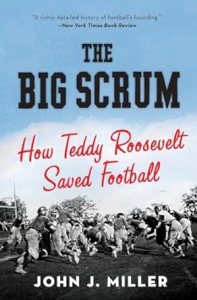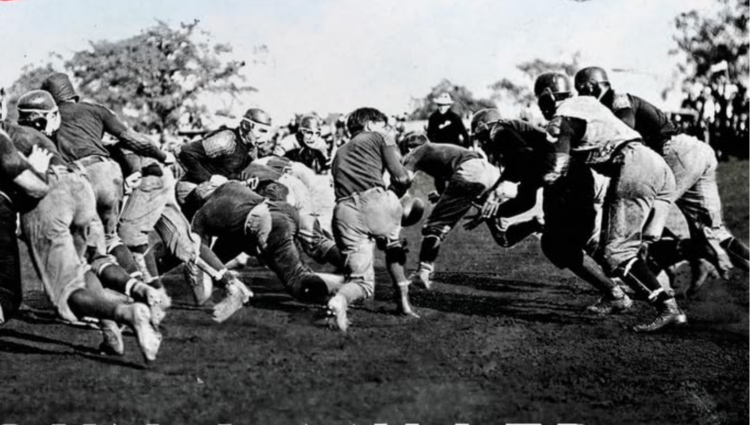“Of all these sports,” Theodore Roosevelt wrote in 1893, “there is no better sport than football.” As in many things, TR was on the cutting edge of cultural opinion in the United States, as it was about to takes its place among the powers of the world. That he too often conflated football and world politics is perhaps an unintended message of John J. Miller’s enjoyable book.
John J. Miller, The Big Scrum: How Teddy Roosevelt Saved Football (272 pages, Harper, reprint 2012)
 “Of all these sports,” Theodore Roosevelt wrote in 1893, “there is no better sport than football.” As in many things, TR was on the cutting edge of cultural opinion in the United States, as it was about to takes its place among the powers of the world. That he too often conflated football and world politics is perhaps an unintended message of this very enjoyable book.
“Of all these sports,” Theodore Roosevelt wrote in 1893, “there is no better sport than football.” As in many things, TR was on the cutting edge of cultural opinion in the United States, as it was about to takes its place among the powers of the world. That he too often conflated football and world politics is perhaps an unintended message of this very enjoyable book.
Sports are inherently conservative. They confront human nature directly. Harvey Penick, one of the great golf teachers of all time, decided in the 1930s not to try the professional tour after he watched Sam Snead hit a few balls. No amount of determination can account for Michael Jordan (who my mother was convinced is a reincarnation of Shaka Zulu), or the great Jim Brown, whom I encountered in an elevator in 1961. About ten years ago, killing time in the airport at O’Hare, I chanced into Terry Bradshaw walking along trying to be inconspicuous, wearing a flannel shirt and jeans with holes, carrying a beat-up duffel bag. I had seen him play many times, of course, and as a commentator. In life he is massive. His arms are too long, and his hands could encircle a good sized watermelon; his jaw alone could provide bone meal for a small garden. These men are not ordinary, and what they are cannot be taught, manufactured, or legislated (for or against). Paul Azinger famously said that there are very few Democrats on the PGA Tour.
John Miller’s book is a pull and a tug about this, although he comes down on the side of football being an organic thing that grew out of the culture of a rapidly changing America. It is interesting that the two great Progressives, Teddy Roosevelt and Woodrow Wilson, were uncompromising football fans. It offends me, in a way. That TR “saved” football by making the NCAA inevitable is like saying that the Food and Drug Administration, which also came about on his watch, “saved” American health.
Mr. Miller tells the story–tells it very well, with spare prose that is both intelligent and accessible–of how football grew into the sport we recognize today as the American game, having supplanted baseball sometime probably about 1965.
It has always fascinated me that the three great purely American sports, football, baseball, basketball, were all invented and nurtured in New England and later became dominated by rural southerners. Baseball was the small town game–all you needed was something to hit, something to hit it with, something to catch it with, and lots of open space. Basketball was an urban game, simple, cheap, requiring a ball and something to put it into, and little space. Football, although capable of being played like baseball, early required complex organization, institutional encouragement, and considerable money, which made it the great corporate game. Ironically, baseball developed as a professional sport, basketball as a high school sport, and football as a college sport. Baseball players in the Negro leagues were making as much money as elite NFL football players in the mid-1930s, and the NBA wasn’t even gleam in the basketball eye until after World War II. College football was drawing crowds of almost 50,000 before 1900; 110,000 in Soldier’s Field by 1925. My Dad played to sold-out Franklin Field in Philadelphia–80,000 people waving hats as they sang “Hail, Pennsylvania”–in 1929. The House that Ruth built could not compete in numbers with Ivy League football.
I am getting away from Mr. Miller’s good book. Despite its title, it is broader: a history of college football, intertwined with Teddy Roosevelt’s life, connected to American culture, from about 1876 to 1906. It’s central characters, besides TR, are Walter Camp, Yale player, coach, promoter and guardian of the game, inventor of the All Americans; and Charles W. Eliot, President of Harvard, the man most committed to erasing football forever from the face of the earth. The book is all Yankeeland; if I could coax a few more pages out of him, I would demand that Mr. Miller include much more of Amos Alonzo Stagg, himself a Yankee and Yalie but also the father of midwestern football, and on Frederick Jackson Turner, who labored long and hard at Wisconsin not only against football in general but against allowing coaching to become a profession. This is a minor complaint. The story is dramatic and thrilling as it is.
The central theme is that football was violent. Duffy Daugherty of Michigan State once quipped that football is not a contact sport, “dancing is a contact sport, football is a collision sport.” In the 1890s football was not unlike Charlemagne’s warfare, minus the swords. Two teams of eleven to fifteen players ran at each other with no protection other than their shirts and pants, often with a head start before the ball was put in play, unable to advance the ball other than by running (a relatively recent innovation) or kicking it. A “wedge” was often used to protect the ball carrier, sometimes with the “V” formation players linking arms for extra strength. Wedge busters were valuable men, but rarely lasted long. A version of this tactic is still a part of football, but usually with less breakable results. Other “mass-momentum plays” were equally as threatening to life and limb. “The rise of mass-momentum plays,” writes Miller, led to the sport’s first crisis.” Boys and men still die from this game, but the mayhem of the late 1890s and early 1900s became a national scandal. Something had to be done, and it was the sitting President Roosevelt who in 1905 summoned leading football men from the Ivy League to the White House and helped get them started on a process of reform.
An interesting aside, and a good insight of Mr. Miller’s, is that the early attempts to protect players from injury (nose-guards, for example) may have had exactly the opposite effect than was intended. The security of protection may have added to the recklessness of play, an observation that I have often thought to be true of today’s game. Such is the protection available that football players often turn themselves into human torpedoes, which no amount of padding can prevent from compressing spines, concussing heads, and distorting knees.
President Eliot of Harvard was the field general of the anti-football forces. His forty years in office spanned the history of football’s development, and he led the charge against it every step of the way. His argument was that football is anti-intellectual, dangerous, ungentlemanly, unfair, deceitful, devoid of “moral quality,” and that “football is a fight, and that its strategy and ethics are those of war.” His ally Shailer Matthews, dean of the Chicago divinity school, capped off this rhetoric by saying, “Football today is a social obsession–a boy-killing, education prostituting, gladiatorial sport.” From the Eliot angle it was hard to argue against his point. Eighteen boys died from football injuries in 1905, and twenty-six in 1909; hardly comparable to mining or industrial deaths, or even on the fledgling roads increasingly populated by the new automobiles, but shocking, nevertheless. Eliot got football banned at Harvard twice, for short periods. “Eliot,” says Mr. Miller, “was football’s prohibitionist.”
Although Eliot insisted that he supported fully the doctrine of mens sana in corpore sano (and the evidence is that he did), he believed that football contradicted it essentially. President Roosevelt disagreed, and the two would but heads over the issue for two decades. “I would a hundred fold rather keep the game as it is now, with the brutality, than give it up,”said TR. “I do not give a snap for a good man who can’t fight and hold his own in the world.” He firmly held that football built character, that it held off the feminization of culture that oozed all around him, and that it firmed up the manliness without which the country could not achieve true greatness. “The Latin I learned in college has helped me a little in after life in various ways,” he said, “but boxing [read here, football] has helped me more.” In his collection of essays, The Strenuous Life, TR wrote, “In short, in life, as in a football game, the principle to follow is: Hit the line hard; don’t foul and don’t shirk, but hit the line hard.” His principle of the Square Deal made him willing to put his prestige on the line to reform the game, but he would not give an inch to what he considered the namby-pambys who wanted to abolish it. One of Mr. Miller’s real contributions to this debate is to describe the “muscular Christianity” that lay behind it. The Frank Merriwell syndrome was as powerful in TR’s culture as Horatio Alger was for ordinary folks. Oh, and I wish Mr. Miller had found a way to include the real life Hobey Baker of Princeton!
Both sides saw implications for American life writ large. Roosevelt was part of the nationalist team that wanted the United States to lead the world, and was convinced that football was the companion to his Charge of the Rough Riders in the Spanish-American War. “Had he been holding a ball instead of a pistol,” writes Mr. Miller, he might have doubled for a rusher who streaks toward the goal line in a mass play.” Those progressives who favored war tended to like football. The members of the Anti-Imperialist League tended to be suspicious of it as too war-like. Mr. Miller never resolves this issue. Recent history’s more conservative Presidents–Ike playing at West Point until his leg went out, Nixon on the bench at Whittier College for four years, Ford a star for the maize and blue, Reagan a tough player at Eureka College and “the Gipper,”–have football credentials. Can one imagine Bill Clinton putting his soft body at risk, or the hoops-loving Obama suiting up with the Redskins? I don’t like the equation of football and war, or aggressive foreign policy, but it would be good to hear Mr. Miller follow up on this tantalizing theme.
This is a book that is fun to read, and that shows the relation between the most serious purposes of our country and our culture. I really doubt that Teddy Roosevelt “saved” football, but he sure made it more interesting.
This essay was first published here in May 2012.
The Imaginative Conservative applies the principle of appreciation to the discussion of culture and politics—we approach dialogue with magnanimity rather than with mere civility. Will you help us remain a refreshing oasis in the increasingly contentious arena of modern discourse? Please consider donating now.


